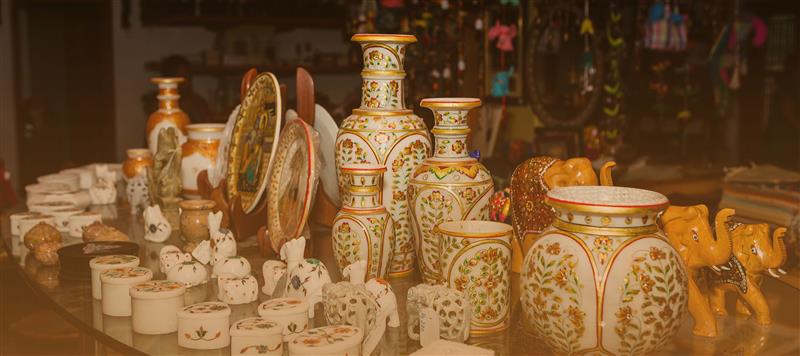Indian Handicrafts: A Growing Trend in US Home Décor
Introduction
In recent years, Indian handicrafts have started to change the look of US home decor, particularly around the festival dates. From Diwali to Thanksgiving, more and more American households are welcoming the texture, craftsmanship, and cultural stories of Indian artisanal items into their homes.
This is not a passing trend: it indicates that consumers are evolving their values about family, supply chains, and how these values impact global decorative goods. In this article, we discuss the implications of Indian handicrafts in US homes, what is driving the change, and how producers and retailers are responding to sustain this engagement.
Cultural Authenticity and Narrative Value
Indian handicrafts do not come to the US simply as functional forms, but as emissaries of centuries of craft practice. From handcrafted brassware to block-printed items to handwoven textiles to Madhubani imagery, for many consumers in the US, these items communicate a sense of connection with multiple forms of tradition, authenticity, and embodied global experiences in their homes.
They can feel from the history of craftsmanship rather than knowing they are manufactured as part of a mass production network for use in decorative objects: instead of simply being from an ancient decorative tradition somewhere in the world, they communicate a story of place, of craft lineage, of regional styles and methods of construction, and of a place interconnected to the craftspeople and items themselves.
Texture, Material, and Craftsmanship
Global minimalism and mass production have moved to more simplistic, homogenized surface structures. The traditions of craftspeople in India move toward imperfection and irregularity: it is the unbleached cotton of Calico, the rough-hewn contours of terracotta, or the gentle rippling effect of hand-spun jute. The tactile quality is being utilized in contemporary interiors as a method of imparting depth. In short, Indian handicrafts are the barometers of size and tactile weight, delivered into our lives.

Sustainable and Ethical Consumption
There is a rising interest in the United States in sustainability and fair-trade sourcing that aligns nicely with many Indian artisan practices. Buyers now want products made with materials that can be traced and that have environmentally friendly sources cotton, wood, recycled metals, etc., and with transparent supply chains. This trend intersects with larger trends in changing consumer expectations in the home decor space, where as much as the “story behind your decor” matters as the décor itself.
Market Pathways: From Indian Workshops to US Living Rooms
Role of Indian handicrafts Online Platforms
The digital revolution has meant that even the most remote artisan groups in Rajasthan, Odisha, or Kashmir have access to a global market. Online marketplaces and craft procurement portals help mitigate geography, and US consumers can now order handmade lamps, hand-loom throws, and carved wood screens directly without intermediary relationships. This accessibility shortens and speeds up the curve for mainstream US home decor.
Wholesale and Bulk Supply Chains
To meet demand at scale – especially for interior designers and retail chains- suppliers in India have begun offering Wholesale Home Decor Items and Wholesale Handicrafts Items to importers and distributors in other countries. Container shipments of brass bowls, decorative mirrors, and carved wood furnishings allow Indian handicrafts to be included in American wholesale home decor catalogs. These new supply ‘chains’ mean that even mid-range home goods stores in the United States can provide reasonably priced artisan products.
Trade Shows and Exhibitions
Indian State Export Corporations and handicraft federations exhibit at American trade shows on a routine basis: Atlanta Gift & Home Market, New York Now, and Las Vegas Market. These shows provide designers and buyers with physical access to materials, finishes, and the stories of artisans, which inspire orders and ultimately place Indian crafts on American store shelves.
Festival Seasons as Catalysts of Adoption
Diwali, Christmas, and Seasonal Cross-Over
Typically, the period from Thanksgiving to the New Year is a prime time for buyers and décor to be refreshed. In India, Diwali is a festival that occurs in late October or early November when a number of decorations are used to create light, rangoli designs, and brass diyas. For American consumers who are celebrating Christmas or New Year, there are opportunities for crossover similar to the way in which an Indian lantern can be a hanging holiday candle holder, a multi-purpose brass bowl can be used for a serving piece or centerpiece, and a block-print floor mat can transition to general décor. Festivals amplify visibility and also provide opportunities for clients to adapt the aesthetics of Indian crafts into their homes without overtly “othering” the décor.
Marketing Campaigns and Cultural Gifting
Retailers in the US and exporters in India often work together to develop festival-based marketing opportunities. An American boutique may carry a “Diwali décor” line, create holiday gift catalogs that include trays with hand-blocked designs, or use social media to tell the stories of artisans who crafted the décor. Each of these examples helps to build a presence around festival-based decor so that interest lasts well beyond the festival
Challenges and Mitigation Strategies
Quality, Consistency, and Scaling
When a craft is handmade, there is a guarantee of variation. This may present a challenge for buyers in the US who are accustomed to uniform or regular finishes and who might seem hesitant to purchase something that has variation. Indian exporters may combat this by putting in place rigorous quality control and onboarding processes that include approvals for samples, coordinating colors, etc., so that they can make sure the uniqueness of artisans is not in conflict with customer expectations.
Supply Chain Delays and Compliance
Shipping products from India could be delayed due to customs, regulatory audits, or holdups. To limit potential delays, exporters engage in pre-clearing documentation before exports, take Incoterms arrangements in favor of buyers, and try to maintain a buffer of inventory in US warehouses. Many exporters also manage ethical compliance, including lab tests related to the presence of lead and VOCs and child labor audits; issues that US importers increasingly demand for compliance.
Price Sensitivity
Indian crafted products usually incur a premium relative to machine-made products. Exporters often will cluster mid-tier lines, including smaller items made of brass, cotton cushions, or carved wood pieces, to appeal to customers looking for affordability while maintaining a level of artisan quality. This is an excellent way to create entry points for customers to try out the aesthetics.
Case Studies: Success Stories from US Homes
Boutique Retailer in Portland
During the 2022 festival season, a small shop in Portland, Oregon, began importing Indian carved wood stools and block-printed throws. Within six months, sales of the products had doubled, and most customers stated that they purchased the items because they were “different.” Now the shop has established a section devoted to what they call “Indo-fusion décor.”
Interior Designer in Dallas
In Dallas, an interior designer has substituted mass-produced accent tables with Indian jali (lattice) screens as side panels in living rooms. The designer’s clients apparently liked the play of light and shadow associated with traditional Indian screen work and started requesting jali screens in subsequent projects.
Looking Ahead: Future Trends
- Hybrid Design Aesthetics: American designers will increasingly merge minimal modes from Western design with Indian craft motifs such as paisleys, moris, or kalamkari.
- Micro-collections Around Regions: States like Gujarat, Assam, or Himachal will likely develop brands so that “Kutch-mirror wall décor” or “Assam silk mitred cushions” becomes a niche line.
- Localized Micro-fulfillment: US importers may establish region-specific craft hubs to stock crafts from Indian crafts near America’s major metro areas (e.g., Atlanta or Chicago) to speed up delivery and customization options (e.g,. initials, variations in color).
- Virtual Reality Previews: Buyers could use AR applications to stage their rooms with Indian handicrafts items prior to ordering, resulting in fewer returns and higher satisfaction rate.
Conclusion
Integrating Indian handicraft products into US home decor is something more than a trend it is an expression of changing consumer behaviors, global linkage, and the growing respectability of handmade meaning.
When there are smart supply chain mechanisms, ethical sourcing practices, and innovative marketing connected to festival cycles, Indian artisans and exporters can tap into considerable market opportunities in the US home decor. For American consumers, this means creating homes that don’t just have a curated look, but tell stories.
Frequently Asked Questions (FAQ)
Sourcing services companies are professional firms that assist businesses with supplier relationship management, with an emphasis on efficiency and compliance, enjoying a long-term relationship and collaboration.
Agents usually manage single transactions, whereas sourcing companies create a working relationship with suppliers by employing a complete supplier relationship management process with strategic oversight.
Because trust and compliance help assure quality, minimize risk, and ensure delivery performance.
Technology provides transparency, risk monitoring, and automates and enables collaboration between buyers and suppliers across borders.
Sourcing services firms help mediate disputes, enforce contractual obligations and formalize a corrective actions plan, whilst assuring business continuity.
No. Small and medium-sized enterprises will also leverage the knowledge of sourcing services companies and access to their network to connect to global suppliers without excess overhead.









